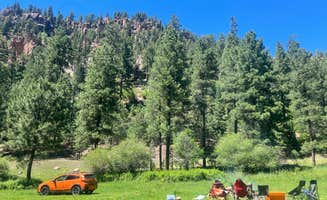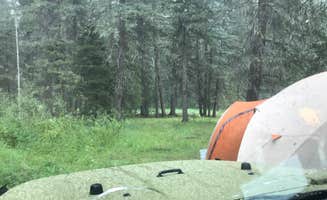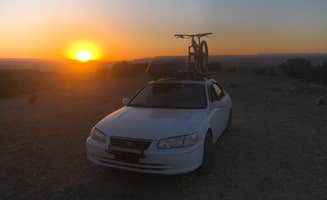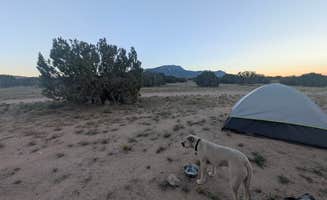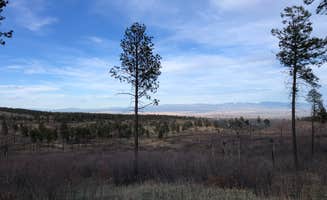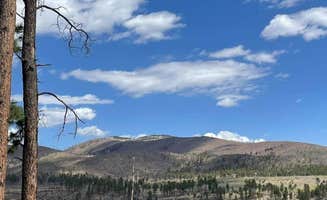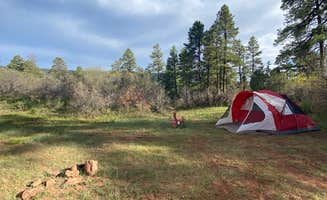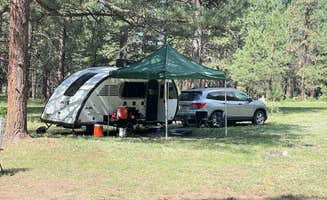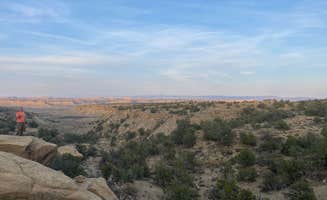Dispersed camping near Jemez Pueblo offers free sites at elevations ranging from 6,000 to 8,500 feet, creating significant temperature variations between seasons and even day to night. Located within the Santa Fe National Forest, these sites sit among ponderosa pines and aspen groves. The area falls within a designated Dark Sky region, making it ideal for astronomical observation during clear nights.
What to do
Explore hiking trails: The Los Conchas Trail connects to many dispersed sites and provides easy hiking along the river. At Top of New Mexico - Dispersed Site, campers can trek the nearby ridgelines. One visitor mentioned, "Incredible scenery, overlooking the valley and mountains in the West, with great sunsets."
Wildlife observation: Free camping near Jemez allows excellent wildlife viewing opportunities. Many sites report wild horse encounters. "My first morning I was surrounded by a group of 5 cows grazing. They ended up laying 30 feet from the trailer all morning," reported one camper at Top of New Mexico. Another camper noted, "Wild horses roamed around our site after sunset. Pretty epic."
Visit geological features: The Jemez Boondocking area provides access to tent rocks and other unique formations. After setting up camp, many visitors drive to the Gilman Tunnels for photography opportunities. "After a few miles you get the opportunity to pass thru the Gilman Tunnels along the Jemez creek. For the next 11 miles there are numerous dispersed camping areas."
What campers like
Night sky viewing: The Dark Sky designation makes stargazing exceptional at many dispersed sites near Jemez Pueblo. At Dispersed on 4 - Fenton Lake State Park, one camper emphasized this experience: "This is a Dark Sky Sanctuary... Beautiful sunrise and sunset. Wild horses in the area. And, you can clearly see the Milky Way. No light pollution except the beautiful view of the city far away."
Privacy between sites: Despite being free camping areas, many sites offer good separation. "The sites are spaced out and pretty large, so privacy shouldn't be an issue," noted a visitor at Pajarito Springs (Dispersed). Another camper described, "Quiet, secluded spaces especially if you drive out the road far."
Temperature comfort: The elevation provides natural cooling during summer months. A camper at Road 378 noted, "It does get cold at night since at approximately 8,000 elevation." This makes the area suitable for summer camping when lower elevations become too hot.
What you should know
Road conditions vary: Many access roads require high-clearance vehicles or careful driving. A camper at FR376 Dispersed advised, "It is a little bumpy and rocky, but there's probably 100 dispersed camping spots. There's ones right on the river, in forrest spots or meadows, you choose!"
Fire restrictions change seasonally: Forest-wide fire bans are common during dry periods, particularly from May through August. "No fires allowed" signs are posted during restrictions. One visitor noted, "There was a site available right as you pulled in and about 3-4 more half developed sites (fire rings) within a quarter mile walk in."
Navigation challenges: GPS directions can be unreliable. A Top of New Mexico camper warned, "Google/Apple directions should not be used, they take you to a locked gate." Another suggested, "Don't arrive when it's dark," highlighting the difficulty of finding suitable sites after sunset.
Elevation impacts: The high elevation means temperature fluctuations of 30-40°F between day and night, even in summer. Pack accordingly with layers and proper sleeping gear.
Tips for camping with families
Choose sites with amenities: While most dispersed camping lacks facilities, a few areas offer basic services. At Road 378, Fenton Lake - Dispersed, campers noted, "The road is a bit rough, but easy access and close enough to the lake that I drove over to kayak after setting up camp. Fire pits set up, the first area is a big open space with a beautiful cliff view."
Wildlife safety measures: Children should understand wildlife boundaries. "We saw one other camper about a mile away," mentioned a visitor, highlighting both the isolation and likelihood of encountering animals without human interference.
Bring entertainment: Limited cell service means kids need offline activities. "No cell service either," reported a camper, suggesting families pack games, books, and other unplugged entertainment options.
Camp location selection: Families should consider camping proximity to facilities. "The first area is a big open space with a beautiful cliff view, we had it to ourselves but could be busy, if you drive further up there are areas to camp that would have more privacy if needed."
Tips from RVers
Road assessment: Before bringing an RV to dispersed sites near Jemez Pueblo, scout the roads first. At Dispersed on 4, a camper advised, "If it has rained the access is washed out and mud holes and ruts and mud will require a 4x4. Access to the spots we were at were up a short steep ridge, again glad for the 4x4. Ground clearance is a must."
Suitable sites for larger rigs: A Top of New Mexico visitor shared, "I didn't make it to the actual coordinates as I took a wrong turn near the end, but there is a ton of open space out here. Easy to get to in 25' RV. Recommend." This indicates that while challenging, RV camping is possible with proper planning.
Levelness considerations: Finding level ground can be challenging in mountain terrain. "The gravel roads are really tight for my 27" trailer, manageable but did rub on a couple of trees and shrubs on the drive in," noted one RVer, suggesting careful site selection is necessary.
Communication capabilities: For those needing to work remotely, connectivity varies by location. "Great Starlink location and pretty good cell service (3/4 bars)," reported a Top of New Mexico camper, while others mentioned spotty or non-existent service in canyon areas.




